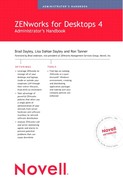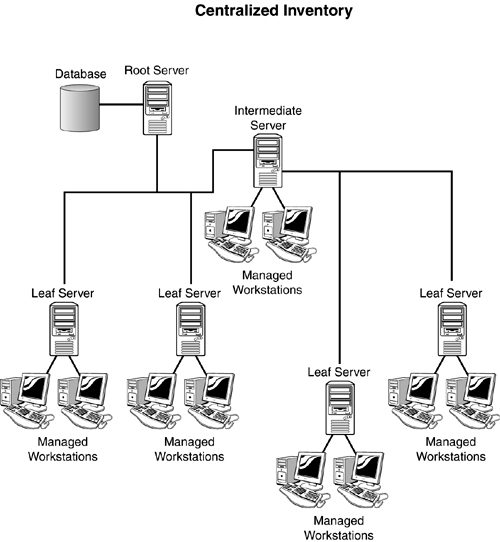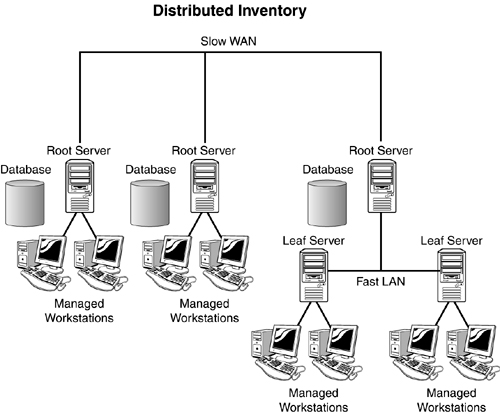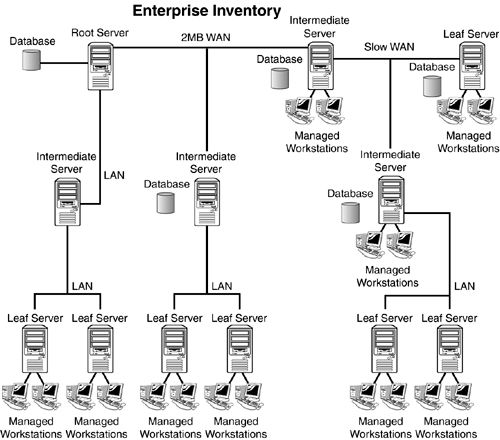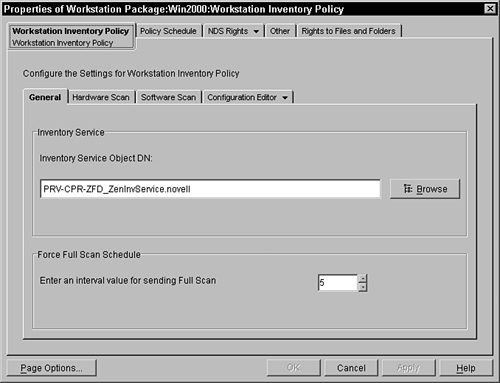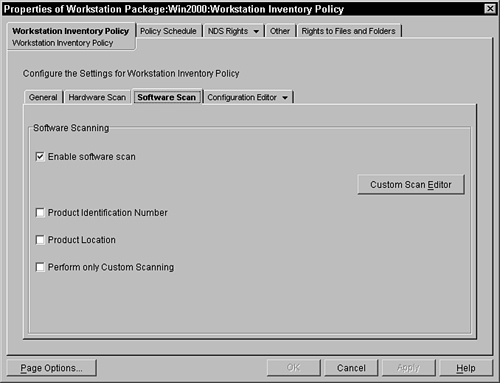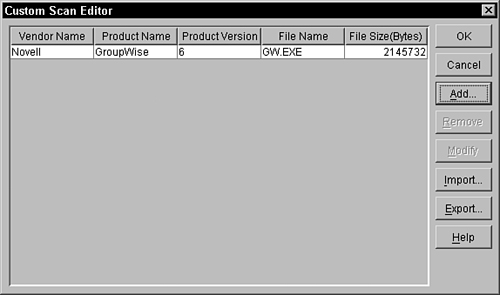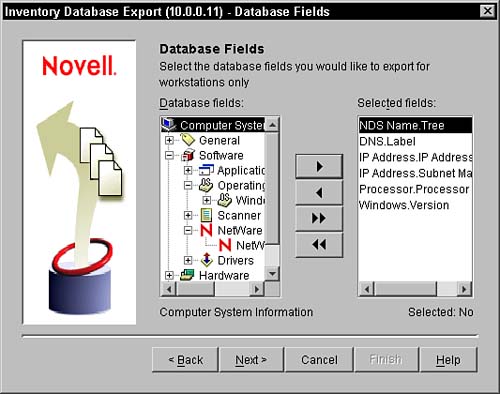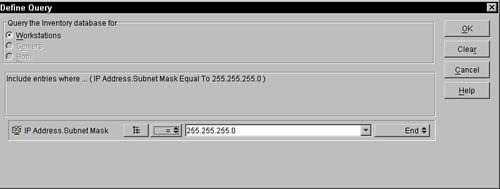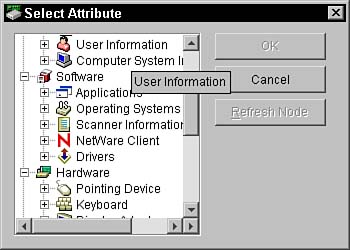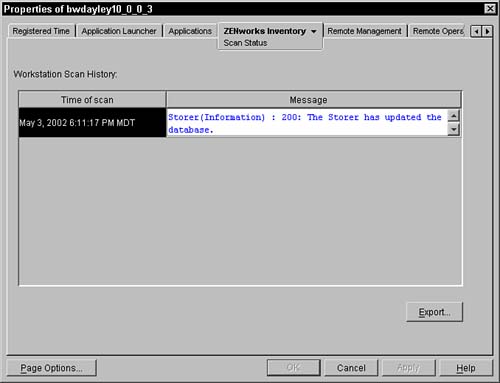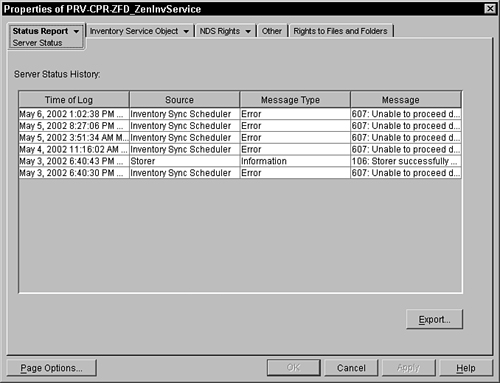ZENworks for Desktops includes powerful workstation inventory software that allows you to gather complete hardware and software inventory for all managed workstations on your network. Once workstations have been imported, you can use the inventory software to collect, store, and report information about the client workstations on your network. This information can be useful in making business decisions on how to manage workstations. The following are some examples of business decisions that can be made from workstation inventory information:
• Which workstations need new applications
• Which workstations need updated hardware and drivers
• Which workstations should receive an application object
• Which workstations are running the corporate software standard
• Which workstations conform to the corporate hardware standard
The following sections describe the workstation inventory process, how to set up inventory in your environment, and which tasks can be performed once it has been properly installed and configured.
To better help you understand how to make the most of the workstation inventory feature of ZENworks for Desktops, you need to know how the process works and which components are involved. The following sections describe the inventory process, the servers that are involved, and the roles they play in various inventory database designs.
The inventory process is the act of acquiring hardware and software information from the workstation, relaying that information to the inventory server, and then storing it into a database for later retrieval. The following sections describe how workstations are scanned, how inventory data is rolled up to the database, what information is collected, and the files and directories involved.
Workstation scanning is done by an application that runs on the workstation. The inventory scanner and all necessary components were installed on the workstation when the ZENworks Management Agent was installed. That application scans the workstation and collects data based on the configurations of the inventory settings. If the workstation is Desktop Management Interface (DMI)-compliant or Web-based Management Interface (WMI)-compliant, the scanner can also query the DMI and WMI service layers to collect data.
Once the scanner has collected information about the workstation, it stores it in an .STR file in the scan directory of the inventory server. The scanner tracks the changes in the scan data by storing it in the HIST.INI file, located in the ZENworks installation directory. Any errors that the scanner reports are stored in the ZENERRORS.LOG file, located in the ZENworks installation directory.
Workstation inventory scanning uses the following steps to update the inventory server and eDirectory:
-
The inventory policies in eDirectory define the inventory settings, such as scanning time, whether to include software scanning of workstations, and the location of the scan directory.
-
The scanner reads the settings in the inventory policies and uses them to collect the workstation inventory information.
-
The scanner stores the scan data of each workstation as an .STR file in the scan directory (
SCANDIR) at the server. -
The scanner also stores a minimal subset of workstation inventory information of the workstation, in the eDirectory workstation object.
-
The selector, running on the inventory server, validates the .STR file and places the file in the enterprise merge directory (
ENTMERGEDIR). If a database is attached, the selector places the files in the database directory (DBDIR). -
If a database is attached to the server, the server updates the database with the inventory information of the .STR file.
-
You can then view the inventory information, query the database, and generate inventory reports in ConsoleOne.
Now that you understand how the inventory scan process works, you need to understand how that information is rolled up to other servers and databases that are higher in the tree. In many networks, one server is not enough to collect and store inventory data for every workstation in the tree. For this reason, you can configure multiple servers to collect inventory data and roll that information up to other servers.
ZENworks uses the following steps to roll up scanned data once it has been collected on a server:
-
Once the selector validates the .STR file and places the file in the enterprise merge directory (
ENTMERGEDIR) for roll-up of scan data, the sending server uses a roll-up policy to identify the server to which it will transmit the scan data. It also reads the roll up schedule to determine the specified time for rolling up the data. -
The sending server compresses the .STR files as a .ZIP file and places the .ZIP file in the enterprise push directory (
ENTPUSHDIR). The sender then sends the .ZIP file to the receiver on the next-level server. -
The receiving server on the next-level receives the .ZIP file and places the file in
ENTPUSHDIR. If this server has a database attached to it or if the server is a root server, the compressed files are placed in the database directory (DBDIR). -
The receiving server extracts the .ZIP file containing the .STR files into a temp directory (
DBDIRTEMP) and updates the database with the inventory information of the workstation .STR file. -
The network administrator can then view the inventory information, query the database, and generate inventory reports in ConsoleOne.
The scan program scans the workstation software for Desktop Management Interface (DMI) software as well as WMI (Web-based Management Interface) systems. Even if both of these are not present, the scanner will contact the hardware directly and then continue to scan the drive for installed software. The software scan performs the following functions based on its setup and configuration:
• Checks for the existence of the software at the workstations and servers.
• Gathers information about the application file.
• Reports the information about the scanned software (such as software vendor, software title, file size, and so on).
• Checks for the software specified in the inventory policy associated with the workstation object.
• Customizes the software scanning based on the software list configured (discussed later).
• Collects configuration file information and reports details and contents of the system files.
• Reports information about the installed drivers.
Workstation inventory uses several files and directories during the scanning and roll up processes. You should be aware of the following files used during the scanning and roll up process:
• HIST.INI—Located in the Windows TEMP directory on the workstation. Contains the history of the scan data for each workstation.
• .STR—Formatted: macaddress_gmt_sequencenumber.STR. Located in the SCANDIR directory on the inventory server. Created by the scanning program. Contains all inventory information scanned from the workstation.
•
.ZIP—Formatted: scheduletime_inventoryservername_siteID_sitename.ZIP. Located in the EntPushDir and DBDir directories. Contains the compressed scan data for several workstations, up to 1000 .STR files, collected by a receiving inventory server. Used to transmit the data from one server to another.
• .PRP—Formatted: scheduletime_inventoryservername.PRP. Located in the .ZIP files. Identifies the information for roll up from the enterprise push directory to the next-level server. The properties file contains the schedule time, inventory server name, and signature that helps to authenticate the .ZIP file.
Once the scan program runs and the hardware and software information about the server is recorded, that information is stored on the inventory servers in the following directory locations:
• ScanDir—Contains the .STR files. This is the raw data collected by the scan programs run at the workstation.
• DBDir—Contains the .STR files for workstations that have been scanned on the network. The .STR files in the DBDir directory are used to update the workstation objects in the database.
• EntMergeDir—Stores the .STR and files created and transferred by the workstation scan programs.
• EntPushDir—Stores the .STR and .ZIP files used to roll up inventory data in an enterprise tree.
Now that you understand how the scan process works, you need to understand what happens to the data that is scanned by the workstations. That data is stored in directories and databases located on inventory servers. The following sections describe the types of servers used in the inventory process.
The root server acts as the highest point in the inventory tree. A root server by default must have a database attached to it. The root server can collect data from intermediate servers, leaf servers, or from workstations attached to it. A root server can be configured only to receive data, not to roll it up to another level.
The intermediate server acts as a staging server to receive data from a lower server in the tree and send it to another intermediate server or to a root server. By default, the intermediate server does not have a database, nor does it have workstations. However, you can configure the intermediate server to have both workstations and a database attached to it. The intermediate server typically receives data from a leaf server or another intermediate server and then rolls it up higher in the tree, eventually to the root server.
The leaf server gathers inventory information from workstations. By default, the leaf server must have workstations attached, but does not have a database attached to it. The leaf server simply gathers data and rolls it up higher in the tree. Typically the data is rolled up to an intermediate server, but a leaf server can also roll data up to a root server.
The stand-alone server acts as a single point of inventory data collection for workstations. The stand-alone server must have both a database and workstations attached to it. The data collected by a stand-alone server cannot be rolled up to another server, nor can information collected by a leaf server be rolled up to a stand-alone server. Typically the stand-alone server is used in small networks where only one inventory server is needed to collect data.
Now that you understand the types of servers that are used for workstation inventory, you need to know the roles they can provide. Depending on their types, each server can be configured to perform one or both of the following two roles.
The first role servers can perform is to have workstations attached. Setting this option means that this server accepts data from the scan programs being run at the workstations. At least one server on the network must be performing this role, but usually most of the servers configured for workstation inventory will be performing the role of collecting data from the workstations. Leaf servers and stand-alone servers always have this option set, but you can configure root server and intermediate servers to have workstations attached as well.
The next role a server can perform is to have a database attached to it. Setting this option means that the server is configured to enter the information scanned by the workstation, either locally or up from a server below, into a local database. This means that a database must be running on the server to accept the information from ZENworks. Root servers and stand-alone servers always have this option set, but you can configure intermediate servers and leaf servers to have a database as well.
Now that you understand the types of servers and the roles they play in workstation inventory, you need to design an inventory tree that matches your network. The following sections describe some common designs for generic networks.
The stand-alone inventory is the simplest design. Only one server is involved. That server acts as the collection and storage service for inventory data scanned from workstations. It has an inventory database installed on it and workstations attached.
This type of design is perfect for smaller networks with 5,000 or fewer workstations. It is easy to maintain and configure; however, it is not scalable.
The centralized inventory design, shown in Figure 13.1, is for large networks where all servers are connected on a LAN. In this approach allowance is made for a larger number of users by adding a number of leaf and intermediate servers for workstation scanners to send their data to.
The centralized inventory approach is still fairly easy to maintain; however, roll up policies must be configured for the intermediate and leaf servers.
The distributed inventory design, shown in Figure 13.2, is for large networks where several remote sites are connected through a WAN. In this approach allowance is made for a larger number of users by creating several root servers, one at each remote site, and then leaf and intermediate servers for workstation scanners to send their data to.
The distributed inventory approach is still much more difficult to maintain because you need to manage several inventory trees. However the distributed approach overcomes problems that can occur, rolling up large numbers of workstations from remote offices.
The final type of inventory design is the enterprise inventory design shown in Figure 13.3. Most enterprise networks take this approach in one form or another. In the enterprise design, accommodations for the large number of users, yet a single management point, is made by creating a single root server and then interlacing intermediate and leaf servers at strategic locations in the network to insure optimal performance.
The best way to achieve an optimal enterprise design is to follow the steps outlined in the following sections.
The first step in designing an enterprise workstation inventory tree is to describe the entire network of your company by doing the following:
Once you have listed the sites in your enterprise network, you need to determine the best place to put the root server. The inventory information stored in the inventory database of the root server consists of all lower-level sites on the network as well as the root server site.
The location of the root server determines the behavior and scalability of your inventory tree. You should consider the following factors when determining its location:
• The root server should be on the site with high network bandwidth.
• A console administrator can collect workstation inventory information from any of the sites connected on high-speed links from the root server, or from the root server level site.
• A database server of suitable configuration can be provided for the inventory server. For a network with 250,000 workstations, the recommended configuration for the root server is 25GB of disk space and 1GB RAM.
Now that you have determined the location of the root server, you need to determine if you need to maintain database servers at different sites. You might want to maintain additional databases if sites or sub-trees are managed for inventory at different locations over a slow link.
You should also consider specific reasons to have a separate database for a single site or a set of sites. Your company might have organizational needs that require the database server to be on different sites.
Note
For a majority of enterprises, there is no need to have any other database besides the enterprise-wide single database. All site-specific reports can be generated from this database easily.
If you determine that another database is required, consider the following to determine the appropriate location and setup:
• Identify the sites that need a database. Additionally, you need to examine whether the database will cater to the local site or a site of sites (sub-tree). Then identify the sites that require data in each inventory database.
• All the sites served by a single database should typically access this database instead of the database at root server for inventory management. This reduces the load on the database at the root server.
• Database administrators should be available for these sites.
Once you have determined any additional databases needed, you need to identify the routes for inventory data for all sites to the nearest database. From those routes, you then need to determine the final route to the database on the root server.
The route plan can become complex, so to help devise a route plan, follow these guidelines:
• Each route can have an intermediate server at a staging site. The Inter mediate Server receives and transmits the data to the next destination. These are application-layer level routes for inventory data. There can be various network-layer level routes between two adjacent servers, which is determined and managed by the routers in the network.
• The route answers the basic question: To which site will the inventory data travel from a particular site so that it eventually reaches the database at the root server, which is its final destination?
• There can be multiple routes. Choose the fastest and most reliable route. To determine the route, consider the physical network links.
• Routes identified once and made operational can be changed later; although there might be some cost in terms of management and traffic generation. If no intermediate database is involved, you can change the route by changing the eDirectory-based policy only.
• Put intermediate servers on sites where the link parameters change substantially. Criteria to consider is difference in bandwidth, unreliability of the links, and need for different scheduling.
• Availability of servers on the intermediate site for staging the inventory data should be considered in deciding the sites for intermediate servers. Provide enough disk space on these servers to store all the inventory data on the disk until the roll-up policy asks to send them to the next destination.
• Workstations should not be connected to the inventory server over a WAN, as the scanning of workstations should not happen across a WAN.
Once you have planned the routes that the data will take to the root server, you need to identify servers on each site to perform the roles necessary to achieve the route. Specifically you need to identify servers to act as inventory, intermediate, and database server.
A single server can have different roles if it has sufficient resources. For example, an inventory server can be a leaf server with a database. You can also designate a server as an intermediate server with a database, which receives inventory from the workstations and also has an inventory database.
When considering the roles of the server, consider the following factors:
• The number of workstations attached to the server also determines the load.
• Take an average of 50KB inventory data from each workstation to calculate the load.
• Any inventory server that has workstations attached to it requires 100KB per workstation.
• The server that has the inventory database requires 200KB per workstation.
• An intermediate server that rolls up data requires 5KB for roll-up of 50KB scan data.
Once you have determined the roles that inventory servers will take at each site, you need to create the tree of servers that will be used for workstation inventory.
Once you have the inventory server tree designed, make certain that the following are true:
• The root of the tree is the root server.
• Servers on each site of the tree represent all the sites in the company.
• At least one server exists per site.
• Assuming that workstations to be scanned exist on each site, there is an inventory server role on each site.
• Optionally, database and intermediate servers exist at the appropriate sites.
Now that you understand how workstation inventory works, you need to know how to set it up and configure it for your network. Once you have installed the appropriate components and you have your workstation inventory tree design completed, you are ready to begin configuring your network to start scanning workstation data and storing it into the inventory database. The following sections describe the configuration process necessary to implement your tree design.
The first step in configuring workstation inventory is to configure the settings for the inventory service object. The inventory service object controls how, when, and where the inventory server collects inventory scan data. The following sections discuss how to configure the inventory service object.
The first thing you must configure for the inventory service object is the roll, scan data time, and path in the Inventory Service object properties page.
From within ConsoleOne, right-click the inventory service object, click Properties, and then click the Inventory Service Object Properties tab as shown in Figure 13.4. From the Inventory Service Object property page, you can configure the options discussed in the following sections.
Figure 13.4. The Inventory Service Object Properties tab for Inventory Service objects in ConsoleOne.
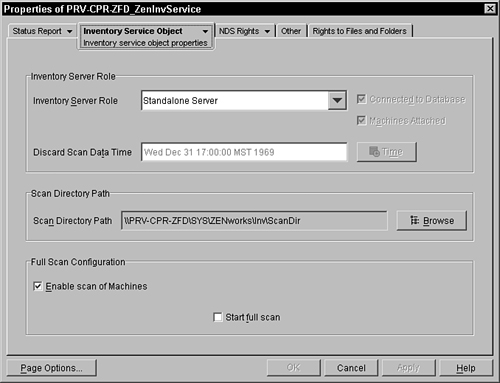
Based on the servers that you have deployed for scanning inventory, you must specify the role of the server. You can select Root Server, Intermediate Server, Leaf Server, or Stand-alone Server based on your inventory configuration.
Set the time at which you want any scan data files (.ZIP files) to be discarded. The scan data files are removed from the server at the time specified in this field. This can be useful in keeping your servers from running out of disk space.
When you install ZENworks for Desktops, you specify the volume on the server for storing the scan data files. If required, you can modify the volume or the directory of the Scan Directory (SCANDIR) setting from the Inventory Service Object property page.
To modify the setting, type the location of the new SCANDIR directory path on the server format of the Scan Directory Path, as follows:
\server_namevolumenamepath
You must select the Enable Scanning of Workstations option in order to scan the workstations associated with the policy. By default, the scanners collect only hardware information of the workstations.
When scanning the workstation for the first time the Scanner collects the complete inventory of the workstation. A complete inventory scan of the workstation is referred as a full scan.
After the workstation is inventoried, the next time the scanner runs, it compares the current inventory data to the history data that it maintains. If any changes to the workstation exist, the Scanner creates a delta scan, which collects the changes in inventory since the last scan was reported. The delta scan setting is the default scan operation for each successive scan after the first scanning of the workstation.
If the status log reported by the inventory component indicates that the scanning on the workstation is not successful, you can force a full scan. This policy's settings are applicable for all workstations associated with it. To override this policy, you set this option for an individual workstation.
Once you have configured the settings on the Inventory Service Object Properties page, you need to configure the sync schedule for the inventory service. The Inventory Sync Service runs on all inventory servers that have inventoried workstations attached to them. The Inventory Sync Service is loaded by the Inventory Service Manager. It removes the redundant or obsolete inventoried workstations from the Inventory database.
Use the following steps in ConsoleOne to configure the Inventory Sync Service Schedule to schedule the Inventory Sync Service to run:
-
Right-click the Inventory Service object and select Properties from the pop-up menu.
-
Select Inventory Service Object tab, Inventory Service Sync Schedule, as shown in Figure 13.5.
-
Modify the schedule settings to schedule Inventory Sync Service to run at the appropriate time.
-
Click the OK button to apply the settings and close the window.
If your workstation inventory tree design includes multiple levels, you need to configure roll-up of scan data in your inventory setup. You need to specify the details, such as the next-level server for roll-up in the Roll-Up Policy that is contained in the Server Policy Package. Use the steps discussed in the following sections to create and configure a role-up policy for scan data.
-
In ConsoleOne, right-click the Server Package, and then choose Properties, Policies. Choose one of the following sub-tabs: General, NetWare, Windows, Linux, or Solaris.
-
Check the check box under the Enabled Column for the Roll-Up Policy.
-
Click Properties. The Roll-Up Policy tab should be displayed.
-
Browse to select the DN of the Inventory Service object. Click OK.
-
Next, select the IP address of the inventory server you want to assign the roll-up policy to. You can also specify a proxy server address and port.
-
Click the OK button to assign the roll-up policy.
-
In ConsoleOne, right-click the Server Package. Choose Properties, Policies. Then choose one of the following sub-tabs: General, NetWare, Windows, Linux, or Solaris.
-
Choose Roll-Up Policy row, Properties, Roll-Up Policy tab, Roll-Up Schedule. Modify the settings for scheduling the roll-up time. Click OK.
The installation program creates the database object for Sybase and configures the database server. However, you need to set up the associations for the database server.
If you are maintaining the inventory database in Oracle or MS SQL Server, you need to perform the tasks in the following sections before making the associations.
-
In ConsoleOne, right-click the Database object. Choose Properties, ZENworks Inventory Database.
-
Browse for the DN of the server or type the server IP address.
-
Use these values for the following options: Database (Read-Write) User Name: MW_DBA; Database(Read-Write) Password: <inventory password>; Database(Read Only) User Name: MW_READER; Database(Read Only) Password: <inventory password>; Database(Write Only) User Name: MW_UPDATER; Database(Write Only) Password: <inventory password>.
-
Click OK.
Table 13.1. Database Settings for a Sybase Database, an Oracle Database, and an MS SQL Server Database
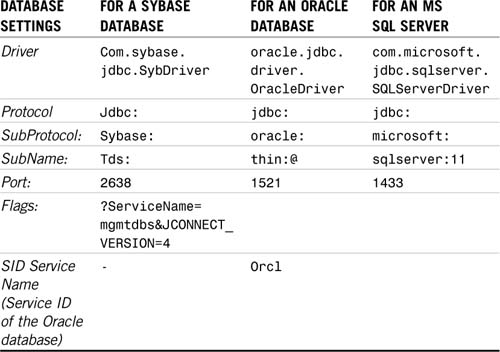
Once you have completed the steps for creating the inventory database in Oracle or MS SQL, or if you are simply using the Sybase database, use the following steps to associate the server.
You must set up the ZENworks database policy to establish the location of the database; otherwise, no information can be logged to the database. To establish the service location of the database, use the following steps:
-
In ConsoleOne, right-click the Service Location Package. Choose Properties, and then click the Policies tab.
-
Check the check box under the Enabled column for the ZENworks database policy.
-
Click Properties.
-
Browse to the DN of the ZENworks Database object and click OK to accept the object. Click OK again to close the ZENworks Database properties window.
-
Select the Associations tab, and then click the Add button.
-
Browse to select the container under which the Database Object is present. Click OK twice.
Once you have configured the server database and service location policies, you need to configure the inventory policies for the workstation. In the Workstation Inventory Policy, you configure the following settings for scanning workstations:
• Scanning time at the workstations
• Inventory server to which the workstations send scanned data
• Include software scanning of workstations
• List software applications for scanning
Use the following steps to configure the Workstation Inventory Policy. First, you need to create a policy package for the workstations:
-
In ConsoleOne, right-click the Container. Click New, Policy Package. Click Workstation Package, and then click Next.
-
Type the name for the Workstation Package. Click Next. Click Finish.
-
In ConsoleOne, right-click the Workstation Package. Click Properties, Policies. Click one of the following sub-tabs: Win95-98, WinNT, Win2000, or WinXP.
-
Check the Enable the Workstation Inventory Policy. Click OK.
-
Click the Associations tab, and then choose Add.
-
Select the container object under which the workstations are registered. Click OK twice.
-
In ConsoleOne, right-click the Workstation Package. Choose Properties, Policies. Then click one of the following sub-tabs: Win95-98, WinNT, Win2000, or WinXP.
-
Select the Workstation Inventory Policy row, Properties, and then the Workstation Inventory tab.
-
Configure the Workstation Inventory Policy as described in the next section.
-
Click OK.
-
In ConsoleOne, right-click the Workstation Package, and then click Properties, Policies. Choose one of the following sub-tabs: Win95-98, WinNT, Win2000, or WinXP.
-
Click the Workstation Inventory Policy row, Properties. Select the Policy Schedule tab.
-
Modify the settings for scheduling the scan of the workstations. Click OK twice.
-
In the Inventory Service Object property page, you enable the scan of the workstations associated with the selected Inventory server.
-
From ConsoleOne, right-click the Inventory Service object (
servername_ZenInvService), and then click Properties. Choose the Inventory Service Object Properties tab. -
Check Enable Scan of Workstations. Click OK.
Once you have finished configuring the workstation inventory policies for workstations, make the following checks in your environment to make certain that the inventory scanning process can complete properly:
• If you have configured the inventory server as a Windows NT/ 2000 server and Windows 98 workstations are present that will send their scan data to that Windows NT/2000 server, you must do the following for the scanners to collect data:
• If eDirectory users are present who are also Windows NT/2000 domain users, ensure that the users logged in are valid users of the Windows NT/2000 domain in the existing share created by ZENworks.
• If users are logged into a different domain, ensure that the users are trusted users of the domain in the existing share created by ZENworks.
• If eDirectory users are present who are not users of any Windows NT/2000 domain, ensure that the users do not log in to eDirectory during workstation start up. However, these users can log in to eDirectory later.
The Workstation Inventory Policy allows you to configure which inventory service that workstations associated with this workstation policy package use. It also allows you to enable and configure hardware and software scanning.
To configure the Server Inventory Policy for a workstation policy package, follow these steps:
-
Right-click the package and select Properties from the drop-down menu.
-
Select the Policies tab for the operating system you want to configure. ZENworks for Desktops 4 allows you to select Win95/98, WinNT, Win2000, WinXP, or general.
-
Enable the Workstation Inventory Policy by checking the box next to it.
-
Select the Workstation Inventory Policy and click the Properties button to bring up the Workstation Inventory Policy Properties window.
The following sections discuss how to configure the Workstation Inventory Policy from this window.
The first step in configuring the Workstation Inventory Policy is to configure which inventory service that workstations associated with this policy will use. Select the General tab in the Workstation Inventory Policy panel as shown in Figure 13.6 and configure the following settings:
• Inventory Server Object DN—Use the browse button to navigate through the eDirectory tree and locate the correct roll-up schedules and locations configured for servers associated with this Workstation Policy Package.
• Force Full Scan Schedule—Once you have selected the Inventory Server Object, you need to specify, in the Force Full Scan Schedule field, the number of delta scans that will occur before a full scan is required.
Next, you need to configure hardware scanning by selecting the Hardware Scan tab, shown in Figure 13.7, and setting the following options:
• Enable DMI Scan—Enables ZENworks to collect hardware inventory data from Windows workstations using the Desktop Management Interface (DMI) 2.0 specification.
• Enable WMI Scan—Enables ZENworks for Desktops 4 to collect hardware inventory data from Windows workstations using the Web-based Management Interface (WMI) 1.5 specification.
• Enable Custom Scanning—Allows you to enable custom hardware scanning and specify a custom scan executable to be run on inventoried workstations.
• Custom Attribute Editor—Allows you to specify a list of custom hardware attributes that should be scanned during the workstation scanning process.
Next, you need to configure software scanning. From the Software Scan tab, shown in Figure 13.8, you can enable the following software inventory options:
• Enable Software Scan—Enables software scanning on workstations associated with this Workstation Policy Package.
• Product Identification Numbers—Scans for product identification numbers of applications that are installed on inventoried workstations. The product identification number can be extremely useful in sorting and organizing inventory software reports.
• Product Location—Allows you to specify software scanning to include scanning of the full path of the product executable installed on the inventoried workstations.
• Perform Custom Scanning only—Allows you to specify software scanning to scan only for the software defined by the custom scan editor.
• Custom Scan Editor—You can click on the Custom Scan Editor button to bring up the Custom Scan Editor window discussed later in this chapter.
Once you have enabled and configured software scanning, you can modify the .INI file that ZENworks for Desktops 4 uses when reporting software inventory. Do this by selecting the Configuration Editor tab, shown in Figure 13.9. You can edit the SWRules file by clicking on the Set Default button to open the default file and then modifying the entries. ZENworks will use this file when you create inventory reports.
Figure 13.9. Configuration Editor for the Workstation Inventory Policy for a Workstation Policy Package.

If you are modifying the Workstation Inventory policy for Windows, the Configuration Editor tab will have a drop-down arrow allowing you to modify the entries in the .INI files for Zipped Names. This allows you to specify the manufacturer of software being used to zip files as well as the identifiers that they are using for the zipped files.
You can also modify the entries in the .INI file for Asset Information. You can specify the DMI classnames and attributes for things such as a workstation model, model number, serial number, and computer type.
Once you have installed, configured, and started the workstation inventory process for you network, you should be aware of several tasks. The following sections describe common tasks that you need to be aware of and use to maintain your workstation inventory.
One important task you should be familiar with is improving the database performance by improving database cache size. You can improve the performance of the Inventory database maintained in Sybase on NetWare or Windows NT/2000 servers. The default database cache size is 32MB; however, this database cache size might not be adequate for large databases with more than 10,000 workstations.
You should change the database cache size to an optimum size. A good rule of thumb is a database cache size that is 1/4 of the database size. You must also consider server memory size while assigning a cache size. For example, if you have 256MB RAM, a cache size of 64MB is recommended.
Use the following steps to change the database cache size on a NetWare server:
-
Close all connections to the Inventory database.
-
Quit the Sybase server.
-
Open the MGMTDB.NCF in
SYS:SYSTEMdirectory. -
Modify the
-cparameter. For example, using-c 64Msets the cache size to 64MB. -
Save the file.
-
On the server console, load the Inventory database. Enter
MGMTDBS.
Use the following steps to change the database cache size on a Windows NT/2000 server:
Another inventory task you should be aware of is backing up the inventory database. ZENworks for Desktops provides an option to back up the Inventory database from the server. It's a good idea to back up the database on a weekly basis. However, if you are tracking the inventory of workstations frequently, increase the frequency of your backups.
The Database Backup tool can be run from ConsoleOne by choosing Tools, ZENworks Inventory, Configure DB, ZENworks Database object. Then click OK. Then choose Tools, ZENworks Inventory, Database Backup. Specify where to back up the database and then click the Start Backup button.
Use the following steps to restore the database:
-
If the Inventory database server is up, stop the database storing service. At the database server console, enter the following:
StopSer Storer -
Quit from the Sybase database.
-
At the database server prompt of NetWare servers, enter
qto stop the Sybase database. -
On Windows NT/2000, stop the Sybase service (Adaptive Service Anywhere - ZENworks for 4Desktops 4).
-
Copy the backup files, overwriting the working database files.
-
Restart the database server.
Note
The backup tool creates a .LOG file located in ZENworks database directory on NetWare and Windows NT/2000 servers. The log records the status of the backup operation. This file increases in size every time a backup is created. Remove the existing contents of the file if you do not need the details.
These steps work for the Sybase database only. For detailed instructions on backing up the oracle database, refer to the online ZENworks for Desktops documentation.
Another important task you should be familiar with is how to customize software scanning. You can customize the list of software applications that you want to scan by specifying the software scan settings in the Workstation Inventory Policy page.
By default, the scanner does not scan for software applications at the workstation. You must enable the software scan option in the Workstation Inventory policy. You should use the Custom Scan Editor to configure the list of applications for scanning. The Custom Scan Editor provides you with a powerful tool to optimize software scanning for your network. Use the Custom Scan Editor to specify the vendor, product name, product version, filename, and file size of the software you want to scan for on servers. This allows you to selectively inventory only software that is important to track reducing the size of inventory reports as well as network and server utilization.
Use the following steps to configure custom application scanning for workstations:
-
In ConsoleOne, select the Workstation Inventory Policy and click Properties. Select the Software Scan tab of the Workstation Inventory Policy page and ensure that the Enable software scan option is checked.
-
Click the Custom Scan Editor button to bring up the Custom Scan Editor, shown in Figure 13.10.
-
Click the Add button to add a custom application to be scanned for.
-
Fill in the details of the application: vendor name, product name, product version, filename, and file size (in bytes).
-
Click OK.
-
To save the application entry in eDirectory, click OK in the Custom Scan Editor dialog box.
You can also add application entries to the Custom Scan table by importing a file with the list of application entries. Use the following steps:
-
Open a text editor.
-
Create a file. The format of the custom scan file is as follows:
total_number_of_application_entries_in_Custom_Scan_file>;total_number_of_columns_in_the_application_entry
vendor_name;product_name;product_version;file_name;file_size(in Bytes)
vendor_name;product_name;product_version;file_name;file_size(in Bytes) -
Save the application as a text file with any extension you prefer.
-
In ConsoleOne, select the Workstation Inventory Policy and click Properties. Ensure that the Enable Software scan operation is checked.
-
Click Custom Scan Editor.
-
Click Import. To save the application entry in eDirectory, click OK in the Custom Scan Editor dialog box.
You should keep the following guidelines in mind if you decide to create your own custom scan files:
• The default total number of columns in the application entry is 5.
• The separator between the columns is a semicolon (;).
• Fill in all the columns for each application entry.
• Do not use comma (,) in the file size parameter.
ZENworks for Desktops includes a tool that allows you to customize inventory data you want from the inventory database and export it to a file. Once you select the inventory components that you need and further filter the data, the export program exports the data into a Comma Separated Value (CSV) file format.
All workstations satisfying the filter you specify in the selected database are exported to a CSV file. If you save the settings, you can later reload the configuration file to export the data. The following sections describe how to set the filters and queries and export the data from either a client or a server.
You can run the Data Export tool from ConsoleOne by choosing Tools, ZENworks Inventory, Configure DB, ZENworks Database Object. Click OK. Then choose Tools, ZENworks Inventory, Data Export to open the Data Export tool.
Once the tool is open, use the following steps to export the inventory data to a CSV file:
-
Select to Create a New Database Query to open the Defined Query dialog box shown in Figure 13.11. This option lets you add a new query that defines the inventory fields such as hardware, software, network, and others that you want to export. You can also specify the criteria to limit the workstations and the database to be included in the query. Based on the inventory components and criteria you specify, the inventory data from the database is exported to a CSV file. Click Next.
-
Specify the scope of the query to be Workstations Servers or both.
-
Form the query and specify the filter conditions as described in the following section by clicking on the Edit Query button shown in Figure 13.11. Click Next.
-
Configure the database fields that you want be exported for the workstations that match the criteria you specified in Step 3. The fields can be added and removed by navigating the Database Fields and Selected fields lists, shown in Figure 13.12, and using the arrow button to add and remove entries. Click Next.
-
View the summary data export settings. Click Save Configuration to save the configurations settings to an .EXP file, specify the filename for the .EXP file, and then click Save. The configuration file (.EXP) contains the settings such as the inventory components you selected, and also the query formed for filtering the workstation data export. You create an .EXP file so that you can reload the configuration settings and generate the .CSV files any time you need to. Click Next.
-
Click Perform the Query from this Computer to run the data export processing from the workstation computer. This option accesses the inventory database on the specified database server and exports the data to a .CSV file. Click Finish.
-
Specify the .CSV filename. Click OK.
This process generates the .CSV file in the specified directory. You can then open the .CSV file in any CSV-supported viewer to view the exported data.
The following sections discuss setting the appropriate query values on the Define Query window shown in Figure 13.13.
Click the Browse Attribute button to select component attributes in the Select Attribute window shown in Figure 13.14. For example, to specify the version of Bios as a component in the data export, select Bios as the component, and select Version as the component attribute.
Components are as follows: Software, Hardware, Network System, DMI, and General Information.
Relational operators show the relationship between the component and the value. Use the Matches option to specify the wildcard characters in the Value field.
Description values are the possible values of an inventory component. For example, 6.0 is a possible value for the DOS-Version attribute. Description values are not case-sensitive. Use the wildcard character % to substitute any number of characters, or the ? character to substitute one character in the Value field.
The list of description values displayed for an Inventory component is taken from the inventory database corresponding to the component.
The connectors and controls available for building filter conditions include the following:
• AND:The expressions before and after the AND must be true.
• OR:Either the expression before the OR or the expression after the OR must be true.
• Insert Row:Lets you build the filter condition for this current row.
• Delete Row:Deletes the row.
• New Group:Lets you form a new filter condition group and specify the criteria for it. This group is combined with the previous group by using the relational operator specified between the groups.
• End:Ends the filter condition.
Accessing the inventory database from a server is recommended if you are exporting data from a large database or if you have specified complex queries for filtering the workstation.
Use the following steps to run the Data Export program from the server:
-
Ensure that you have generated the data configurations files. Then perform Steps 1 through 5 of the “Exporting Inventory Data from ConsoleOne” section of this chapter. Also ensure that you save the settings in the .EXP file.
-
Click Perform the Query on a Remote Server to run the data export program from any server that has Workstation Inventory components installed. Click Finish.
-
From the server console, run
DBEXPORT.NCFon NetWare servers orDBEXPORT.BATon Windows NT/2000 servers, by typingDBEXPORTconfiguration_filename.exp csv_filename.csvwhereconfiguration_filename.EXPis an existing file that contains the data export settings. The data exported from the database is stored in thecsv_filename.csvfile. The corresponding .CFG file for the .EXP file should be in the same folder as the .EXP file. The .CFG file contains the list of the database attributes to be exported. -
Choose the Inventory sites.
-
If you want to export the data from all database sites, satisfying the filter conditions, type 0.
-
To choose the database sites, type the numbers corresponding to the site names in the displayed list.
-
To select multiple site databases, separate the site numbers corresponding to the site names by commas.
The data export displays the number of workstations that satisfy the query and filter conditions for export.
-
Open the .CSV file in Microsoft Excel, or any other CSV-supported viewer to view the exported data.
Another important inventory task you should be familiar with is viewing the information in the workstation inventory. The following sections describe how to view information about managed workstations.
Workstation inventory scanners store a subset of the scan data directly into the workstation object in eDirectory. You can view that information by right-clicking the Workstation object and selecting Properties, ZENworks Inventory tab, Minimal Information.
The minimal view, shown in Figure 13.15, displays the following information about that workstation: asset tag, BIOS type, computer model, computer type, disk information, IP address, IPX address, last scan date, MAC address, memory size, model number, NIC type, Novell client, OS type, OS version, processor, serial number, subnet mask, and video type.
If the minimal inventory information does not show all you need, you can see the complete listing from ConsoleOne by clicking Tools, ZENworks Inventory, Configure DB. Right-click the workstation object, and then choose Actions, Inventory.
The summary view, shown in Figure 13.16, allows you to view the entire listing of the inventory scan data for the workstation object.
If the entire listing for the workstation object is too much for you, you can view only the information that you requested by performing a query. Use the following steps to view the information that was formed by a query:
-
In ConsoleOne, click a container.
-
Choose Tools, ZENworks Inventory, Configure DB.
-
Choose Tools, ZENworks Inventory, Inventory Query.
-
From the Inventory Query dialog box, shown in Figure 13.17, specify the criteria for the query. Set the Find in, Search Entire Database, Find Type, Attributes, Operator, Value, and Save options for the query.
-
Click Find.
A query is run on the database and the results are displayed for you to view.
Another inventory task that is useful is running inventory reports. You can run reports from a predefined list to gather inventory information from the inventory database. Once you run the report, it can be printed or exported as desired.
Use the following steps to generate the inventory report:
A status box appears displaying the progress of the report generation. When the report is generated, it appears in the viewer. Use the buttons on the toolbar to page through, print, or export the report.
Table 13.2. Report Types and Criteria for Inventory Reports
|
NAME (SIMPLE/COMP) |
CRITERIA[*] |
DESCRIPTION |
|---|---|---|
|
Scan Time Listing(S) |
Last Scan Date |
Data and time of the last Inventory scan on each workstation |
|
Operating System Listing(S) |
OS Type, OS Version |
List of all the workstations with an OS Type, an OS Version, and the total number of such workstations |
|
BIOS Listing(S) |
BIOS Install Date |
List of all the workstations with a BIOS release date, and the total number of such workstations |
|
Processor Family Listing(S) |
Processor Family |
List of all the workstations with a processor family (such as Pentium[*] Pro), and the total number of such workstations |
|
Processor Current Clock Speed(S) |
Lower Bound, Upper Bound |
List of all the workstations within a range of processor speed (such as 200-1000 MHz), and the total number of such workstations |
|
Processor Maximum Clock Speed(S) |
Lower Bound, Upper Bound |
List of all the workstations within a range of maximum processor speed (such as 200-1000 MHz), and the total number of such workstations |
|
Video Adapter Listing(S) |
Video Architecture |
List of all the workstations with a video adapter (such as MGA 2064W), and the total number of such workstations |
|
Network Adapter Listing(S) |
Adapter Name |
List of all the workstations with a network adapter (such as 3Com[*] Fast EtherLink[*]) and the total number of such workstations |
|
Software Listing(S) |
Software Name and Version |
List of all the workstations with a software name, version and the total number of such workstations |
|
Software Summary Listing(S) |
Software Name and Version |
Lists of the total number of workstations with a particular software and version |
|
Application Software Inventory Report |
DN of Workstation |
Software information including product name, version and vendor on each workstation |
|
Asset Management Report |
DN of Workstation |
BIOS, computer description, processor, and OS Description for each workstation |
|
System Internal Hardware Report |
DN of Workstation |
Memory, processor, display details, physical disk drive, and modem for each workstation |
|
Networking Information Report |
DN of Workstation |
OS Description, MAC Address, NIC Type, IP Address, and Network Drive mappings for each workstation |
|
Storage Devices Inventory Report |
DN of Workstation |
Hard disk, removable disk, logical drives, disk and CD-ROM details for each workstation |
|
System Software Inventory Report |
DN of Workstation |
OS description, display drivers, pointing device drivers, network adapter drivers and NetWare Client details for each workstation |
|
System Peripherals Inventory Report |
DN of Workstation |
Computer description, display details, keyboard, pointing device and network adapter details for each workstation |
[*]The IP Address, DN, Distinguished Tree, and DNS name can be used as criteria for all workstation inventory reports. |
||
Another valuable task that you should frequently perform is to view the status and scan logs generated by workstation inventory. The following sections list the logs, what they contain, and how to access them.
The workstation scan log monitors information from scan programs and the database storage process on the server. It contains the scanned workstation name, time of scan, inventory component, message type, and status message.
To access the workstation scan log from within ConsoleOne, select the container; then choose Tools, ZENworks Inventory, Workstation Scan Log. The Workstation Scan Log, shown in Figure 13.18, displays a listing of inventory scans that have occurred on the configured inventory database.
The roll-up log contains information collected from data sending servers, data receiving servers, and the database storage process. The roll-up log contains information about where the roll-up initiated from, roll-up start time, inventory component, message type, and status message.
To access the roll-up log from within ConsoleOne, select the container for the Inventory Service Object and then click Tools, ZENworks Inventory, Roll-Up Log.
The workstation scan status monitors information from the scan programs and the database storage process. It contains the time of scan and status message.
To access the workstation scan status from within ConsoleOne, right-click the workstation object and click Properties, ZENworks Inventory tab, Scan Status. The Scan Status tab, shown in Figure 13.19, displays the time of each scan as well as status messages that occurred during the scan. You can use the up and down arrows to navigate through the status messages.
The status of inventory components on the server contains information gathered from the sending server, receiving servers, the selector on the server, the database storing process, the service manager, and the roll-up scheduler. It shows the time of log, source, message type, and a textual message.
To access the status of inventory components on the server from within ConsoleOne, right-click the Inventory Service object and then click Properties, Status Report, Server Status.
The roll-up status contains information gathered from the sending server, receiving servers, and the database storing process. It shows the roll-up start time and message.
To access the roll-up status from within ConsoleOne, right-click the Inventory Service object. Then choose Properties, Status Report, Roll-Up Status.
